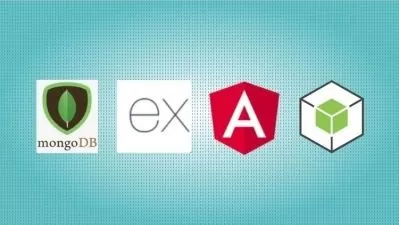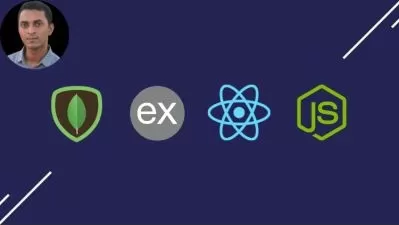MongoDB - The Complete Developer's Guide 2023
Academind by Maximilian Schwarzmüller,Maximilian Schwarzmüller
14:54:38
Description
Master MongoDB Development for Web & Mobile Apps. CRUD Operations, Indexes, Aggregation Framework - All about MongoDB!
What You'll Learn?
- Learn what document databases are and how data is organized with MongoDB
- Learn how to perform CRUD operations with MongoDB
- Don't stop at the basics - learn all about writing complex MongoDB queries, in-depth and with practical examples!
- Write efficient and well-performing queries to fetch data in the format you need it
- Use all features MongoDB offers you to work with data efficiently
Who is this for?
What You Need to Know?
More details
DescriptionJoin this bestselling MongoDB course to learn all about this extremely popular database and query language from the ground up, in great detail and with many practical examples!
MongoDB is one of the most important NoSQL databases you can work with these days. It's extremely popular and MongoDBÂ developers are in high demand.
No matter if you're building web applications, mobile applications or any other kind of application or if you're a data scientist - you'll need to work with data. Storing data, querying it efficiently and minimizing complexities whilst optimizing performance are crucial tasks.
MongoDB makes working with data simple - it's built on a philosophy that prioritizes performance and efficiency.
In this course, you'll learn all about MongoDB from scratch. No prior MongoDB or database experience is required!
In detail, you'll learn:
... how to install and use MongoDB locally and in the cloud (MongoDBÂ Atlas)
... how to perform CRUD (Create, Read, Update, Delete) operations on MongoDB databases
... how to filter for data efficiently
... how to work with both the Mongo Shell and drivers (e.g. Node.js driver)
... how to increase performance by using indexes (and how to use the right indexes!)
... how to use the amazing "Aggregation Framework" that's built into MongoDB
... what replica sets and sharding are
... how to use MongoDBÂ Atlas - the cloud solution offered by MongoDB
... how to use the serverless platform (Stitch) offered by MongoDB
... and much more!
This course is a hands-on course - you'll learn by writing code/Â commands. We'll work on a wide variety of example data and use-cases and by the end of the course, you'll have all the knowledge you need to work with MongoDBÂ in your next project!
This course is for you, no matter which programming language you plan on using, you'll learn a uniform way of interacting with MongoDB that can be easily applied to any language.
This course is for you:
... if you're brand-new to MongoDBÂ and databases in general
... if you got some basic database or even MongoDB experience - in this course, there are different entry points you can choose from!
... if you are a web or mobile app (or desktop app) developer who considers using MongoDB
... if you're working in a team that considers using MongoDBÂ (or already does use it)
... if you are primarily using SQL-based databases so far and you want to explore the most popular NoSQLÂ alternative
This course is NOT for you:
... if you're looking for a guide on administrating MongoDB servers =>Â This course focuses on the commands/Â queries you write, it's NOTÂ an administration course. I will show (in detail) how to deploy a ready-to-use cloud MongoDBÂ solution that follows best practices though.
Who this course is for:
- Developers or data scientists who plan on (or are already) working with MongoDB
- Everyone who's interested in NoSQL databases
- Both beginner and advanced MongoDB users who want to explore all the core features
Join this bestselling MongoDB course to learn all about this extremely popular database and query language from the ground up, in great detail and with many practical examples!
MongoDB is one of the most important NoSQL databases you can work with these days. It's extremely popular and MongoDBÂ developers are in high demand.
No matter if you're building web applications, mobile applications or any other kind of application or if you're a data scientist - you'll need to work with data. Storing data, querying it efficiently and minimizing complexities whilst optimizing performance are crucial tasks.
MongoDB makes working with data simple - it's built on a philosophy that prioritizes performance and efficiency.
In this course, you'll learn all about MongoDB from scratch. No prior MongoDB or database experience is required!
In detail, you'll learn:
... how to install and use MongoDB locally and in the cloud (MongoDBÂ Atlas)
... how to perform CRUD (Create, Read, Update, Delete) operations on MongoDB databases
... how to filter for data efficiently
... how to work with both the Mongo Shell and drivers (e.g. Node.js driver)
... how to increase performance by using indexes (and how to use the right indexes!)
... how to use the amazing "Aggregation Framework" that's built into MongoDB
... what replica sets and sharding are
... how to use MongoDBÂ Atlas - the cloud solution offered by MongoDB
... how to use the serverless platform (Stitch) offered by MongoDB
... and much more!
This course is a hands-on course - you'll learn by writing code/Â commands. We'll work on a wide variety of example data and use-cases and by the end of the course, you'll have all the knowledge you need to work with MongoDBÂ in your next project!
This course is for you, no matter which programming language you plan on using, you'll learn a uniform way of interacting with MongoDB that can be easily applied to any language.
This course is for you:
... if you're brand-new to MongoDBÂ and databases in general
... if you got some basic database or even MongoDB experience - in this course, there are different entry points you can choose from!
... if you are a web or mobile app (or desktop app) developer who considers using MongoDB
... if you're working in a team that considers using MongoDBÂ (or already does use it)
... if you are primarily using SQL-based databases so far and you want to explore the most popular NoSQLÂ alternative
This course is NOT for you:
... if you're looking for a guide on administrating MongoDB servers =>Â This course focuses on the commands/Â queries you write, it's NOTÂ an administration course. I will show (in detail) how to deploy a ready-to-use cloud MongoDBÂ solution that follows best practices though.
Who this course is for:
- Developers or data scientists who plan on (or are already) working with MongoDB
- Everyone who's interested in NoSQL databases
- Both beginner and advanced MongoDB users who want to explore all the core features
User Reviews
Rating
Academind by Maximilian Schwarzmüller
Instructor's CoursesMaximilian Schwarzmüller
Instructor's Courses
Udemy
View courses Udemy- language english
- Training sessions 238
- duration 14:54:38
- English subtitles has
- Release Date 2023/10/08












